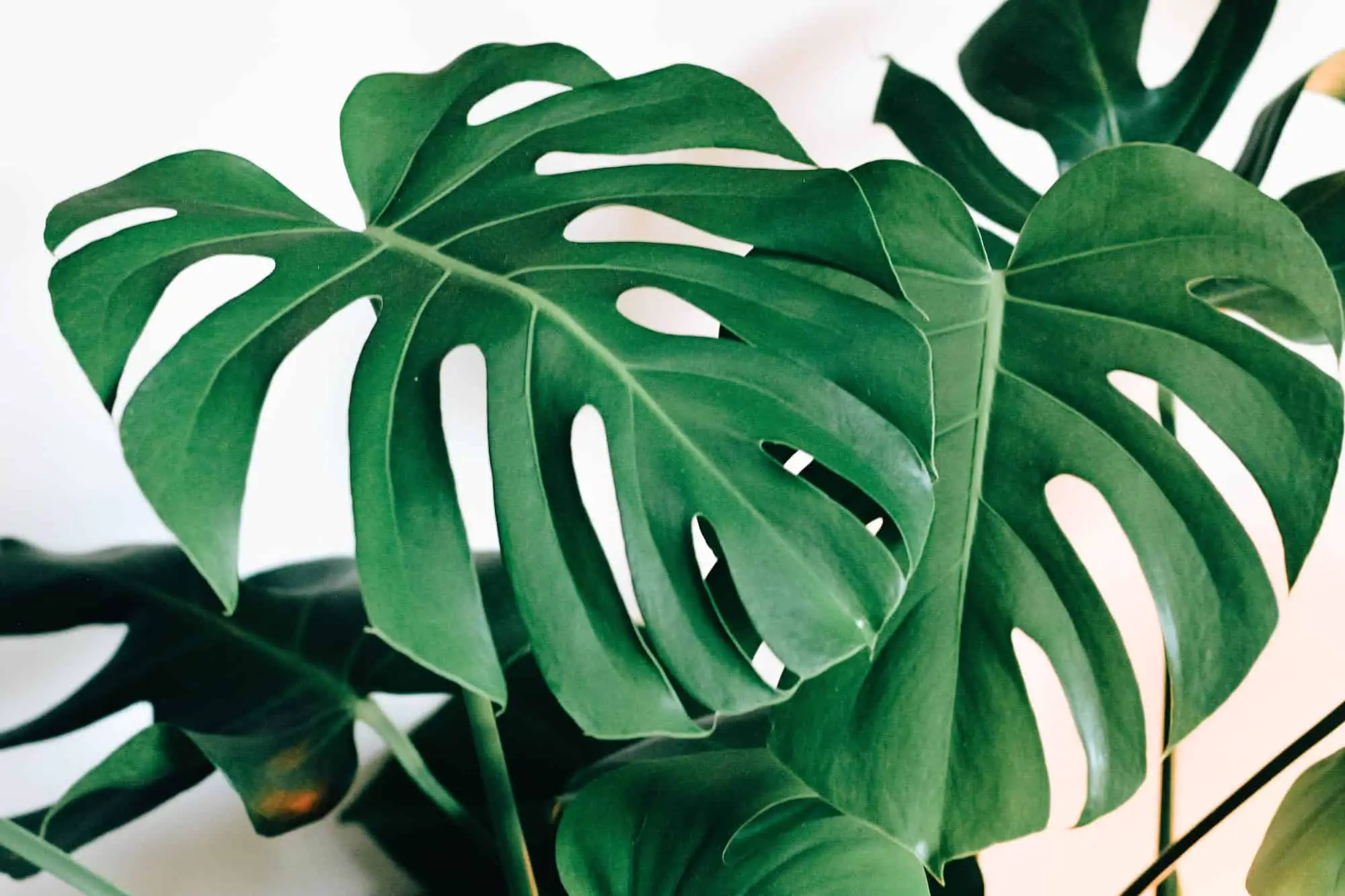Monstera deliciosa, which is commonly known as Swiss Cheese Plant has recently become increasingly popular, and it is easy to see why. Its smooth, glossy leaves make it an attractive addition to homes, offices, and hotels. In addition, the holes that this plant is named for also give it a modern appearance.
To successfully grow Swiss Cheese Plant, place it in a spot that is exposed to bright, indirect light. These plants need light to form the slits that make them so unique. In addition, Swiss Cheese Plant should be planted in well-draining soil and should be watered after the top two inches of soil have dried completely. Finally, these plants need to be in a humid environment, so consider purchasing a plant humidifier or placing a pebble tray near your Swiss Cheese Plant.
Another characteristic of Swiss Cheese Plant is that these plants are fairly easy to grow. However, they do require care and attention because the conditions inside most homes are not the same as their native environment. The rest of this article will give you a little background on these plants and provide a detailed care guide so you can enjoy your Swiss Cheese Plant for several years.
About Swiss Cheese Plant
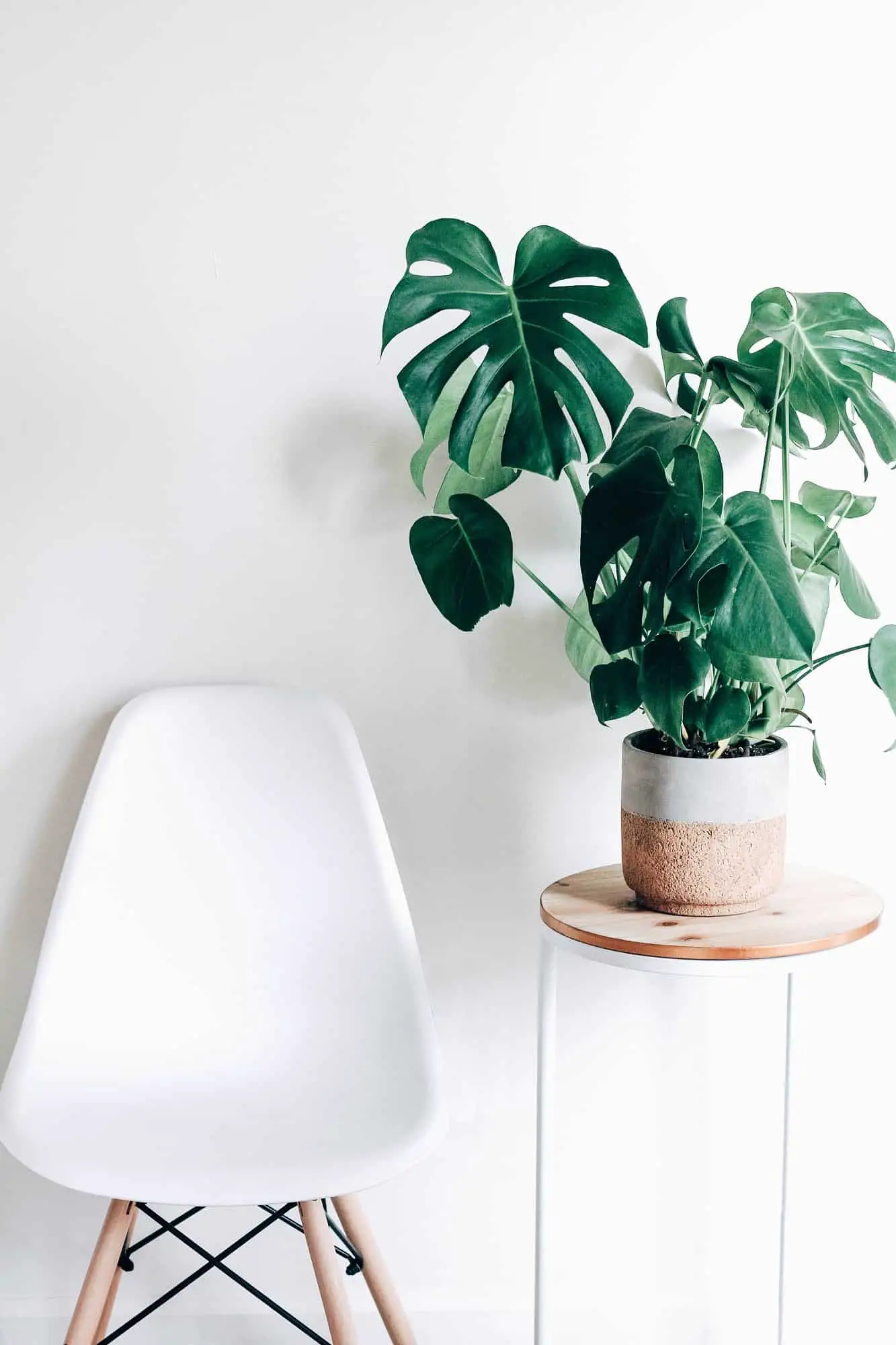
Swiss Cheese Plant is one of 20 species that belong to the Monstera genus. In the wild, they grow as hemi-epiphytes which means that their seeds germinate on the forest floor. After germinating, the plant begins to search for a tree to “climb” up.
Monstera deliciosa is native to the tropical rainforests of Mexico, Panama, Guatemala, and Costa Rica. However, they can also be found growing wild in parts of Asia, Australia, and parts of the Mediterranean. Swiss Cheese Plant was first introduced to England in 1752. The fruit of this plant was introduced to the United States in 1874.
Swiss Cheese Plants can be grown outdoors in United States Department of Agriculture (USDA) hardiness zones 10 and 11 – areas that do not experience frost. For example, you will often see them in South Florida. In these types of conditions, the vine can become somewhat invasive.
Swiss Cheese Plant Root Development
As the Swiss Cheese Plant grows, it develops two kinds of roots: anchoring roots that attach it to the trunk and aerial roots. The purpose of the aerial roots is to help the plant climb towards the light.
Swiss Cheese Plant Blooms
Swiss Cheese Plant can potentially start blooming about three years after planting it in the right outdoor conditions. The blooms eventually turn into fruit (see next section). Unfortunately, flowering rarely occurs when these plants are grown indoors.
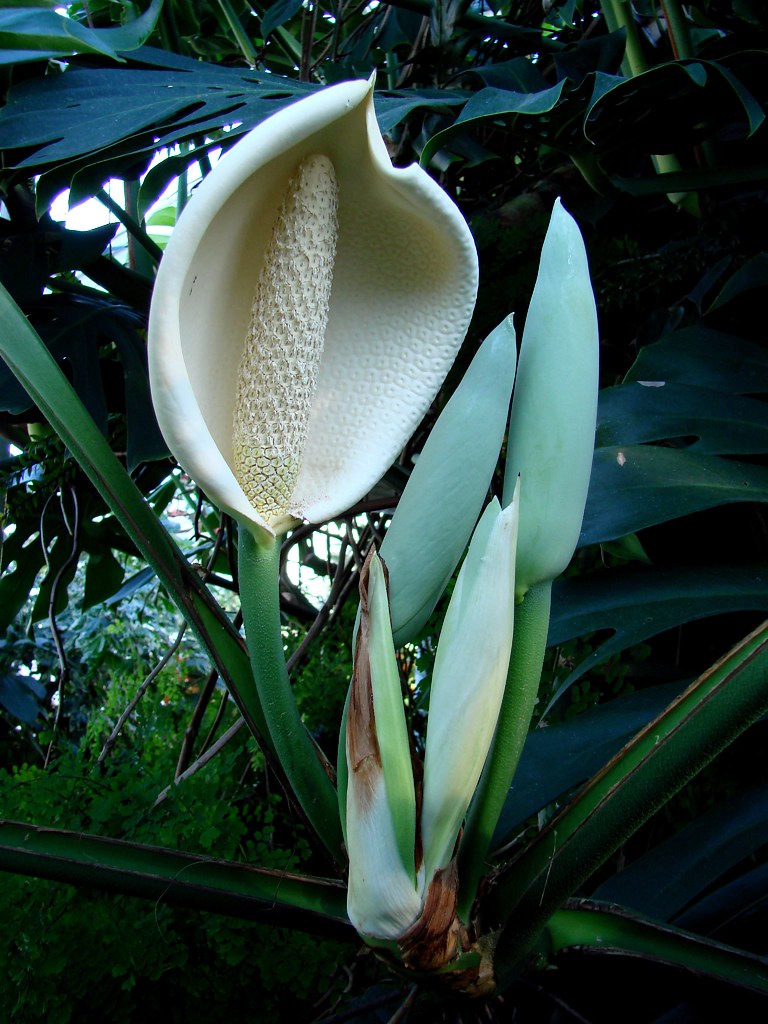
Monster Fruit
Although Swiss Cheese itself is not edible, these plants can produce a fruit, commonly known as monster fruit, that is edible once it is ripe. Monster fruit looks like a green ear of corn covered with hexagonal scales as shown in the picture below.

Ripe monster fruit tastes like a blend of pineapple and banana. Because ripe monster fruit tastes like a blend of different fruits, Monstera deliciosa is sometimes referred to as the Fruit Salad Plant.
However, I recommend not trying to eat monster tree directly from this plant. If you eat unripe monster fruit, it can cause significant irritation to your throat and skin. This is because unripe monster fruit contains a large amount of oxalic acid which is used to remove some paints and varnishes. It takes monster fruit between 12 and 18 months to ripen. The fruit also requires ideal conditions (e.g., tropical heat and humidity) to fully ripen, so it is highly unlikely that your Swill Cheese Plant will ever produce any edible fruit.
Do not eat any part of your Swiss Cheese Plant because every part of the plant is poisonous at some point during its growth cycle!
Most people agree that it is best to avoid eating any part of your Swiss Cheese plant because every part of this plant is poisonous at some point during the growing cycle. If you believe that your plant has produced edible fruit, consult with a professional before actually eating the fruit.
To learn more about monster fruit, I recommend watching the video below.
Light Requirements For Swiss Cheese Plant
In the wild, the Swiss Cheese Plant tends to grow under a canopy of other plants. This means that they are not exposed to direct, bright light in their native environment.
This is important to keep in mind when selecting a home for this plant. It is important to place your Swiss Cheese Plant in a location that is exposed to light that is too intense/bright. You would be surprised at how easily the plants of these leaves will burn. If you see dry, brown spots forming on the leaves, your plant may be getting too much light.
These plants do best in an area with partial shade, but they do still need a lot of ambient light. These plants will lose the holes that give them that “swiss cheese” look if they are not exposed to enough sunlight.
If your Swiss Cheese is not getting enough light, you might see the leaves of your plant starting to spread into a darker area of you home. This is called negative phototropism. It may seem a bit seem counter intuitive for a plant to seek light by spreading into dark areas, but Swiss Cheese Plant does this because the plant is seeking tall trees to climb up in order to find light. In the wild, dark areas indicate tall trees.
Phototropism is plant growth toward or away from light. Negative Phototropism is growth away from light.
Swiss Cheese Plant will not “know” that the dark areas in your home are probably going to remain dark, so it is best to move it to a brighter area if you start to see signs of spreading.
Cleaning Swiss Cheese Plant’s Leaves
Cleaning the leaves of your plants ensure that it is able to absorb light and photosynthesize properly. It may seem a bit strange to clean leaves when plants live in soil, but it really does make a difference. Over time, a layer of dust will accumulate on the leaves of your plant. This layer of dust blocks sunlight and reduces the plant’s ability to photosynthesize. Because plants feed themselves through the process of photosynthesis, this layer of dust can negatively impact the plant’s ability to grow.
The easiest way to clean the leaves of your plant is to spray the leaves with a dilute mixture of soapy water (3 tsp for every gallon of water) and rinse off the leaves in the sink or with a hose.
Another way to clean your plants is to gently wipe off the leaves with a damp cloth. Personally, I find this method to be therapeutic. It is also a good opportunity to closely inspect your plant and identify any possible pest or disease issues.
I recommend cleaning the leaves of your plants on a monthly basis. If you live in a dusty area or near a construction site, consider cleaning the leaves of your Swiss Cheese Plant more often.
Soil Mix For Swiss Cheese Plant
Like most houseplants, Swiss Cheese Plant needs to be planted in a well-draining soil to avoid root rot. A standard potting soil mixed with some peat and orchid bark is fine for Swiss Cheese Plant. Peat holds several times its weight in water. The roots of the plant can access this water when needed. In addition, peat holds onto nutrients that would otherwise be washed away when watering the plant.
If you are willing to mix your own soil, consider making Al’s 5:1:1 potting mix which consists of the following:
- 5 parts pine bark
- 1 part coarse perlite
- 1 part peat
- 1 Tbsp of garden lime per gallon of soil
- Time-release fertilizer (optional)
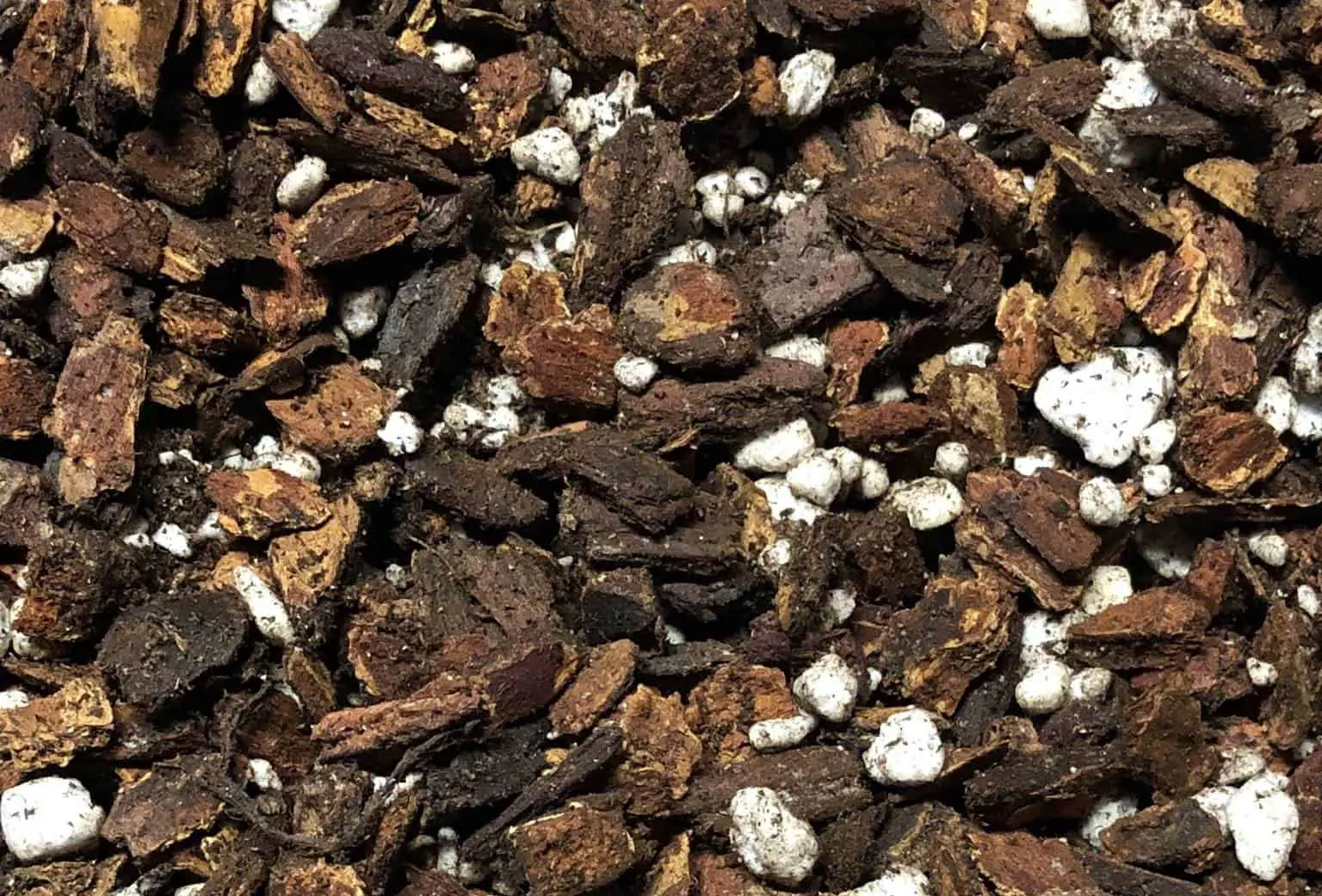
My Swiss Cheese Plant came in a potting mix similar to Al’s 5:1:1 potting mix, and it is doing very well. This potting mix works well for other houseplants and helps prevent issues associated with overwatering.
Note: If you are wondering who Al (talpa) is, he is a popular contributor to the Houzz forum. Click here to read one of Al’s detailed articles.
Watering Swiss Cheese Plant
Watering is a very important aspect of Swiss Cheese Plant care. The frequency of watering depends on a variety of factors including how much light your plant is getting, the size of your plant, the time of year (water less frequently during the winter), and the relative humidity of your home. Only water your Swiss Cheese Plant after the top two inches of soil has dried.
Make sure to water your Swiss Cheese Plant thoroughly. This is important because it will flush excess fertilizer/minerals through the soil profile.
Watch for signs that you need to adjust your watering regime. Wilting or droopy leaves are a sign that your Swiss Cheese Plant is not getting enough water. Brown, crispy, or curling leaves are also a sign that you are underwatering your plant.
Like many epiphytes with aerial roots, the Swiss Cheese Plant is sensitive to overwatering. It is very important to make sure that your plant is NOT sitting in soggy soil. When you press your fingers into the soil, it should feel spongy. Water should not pool around the fingers.
Yellow leaves could be a sign of overwatering or underwatering. If you see yellow and brown on the same leaf, you are probably overwatering your plant. Brown or black leaves are also be a sign of overwatering.

Why is my Swiss Cheese Plant crying?
At some point, you may see water droplets on the tips of your plant leaves. This phenomenon is called guttation. Guttation is a term that describes drops of xylem sap on the tips or edges of leaves. This is a natural phenomenon. Like many plants, Swiss Cheese Plant close their stomata at night. If the soil has high water content, water will enter the roots and cause high root pressure. This root pressure forces water through hydathodes, which are special leaf pores.

Do not confuse guttation with dew. Dew and guttation may look similar, but they are not the same thing. Dew occurs when water from the atmosphere condenses on the surface of the plant leaves. In contrast, guttation is water from the plant itself.
Guttation is common after watering and is typically not a problem. However, if your soil has a high mineral content, a white crust may form after the water evaporates and cause leaf burn. Continuous “crying” may indicate that you are overwatering your plant.
Fertilizing Swiss Cheese Plant
After researching the feeding requirements for Swiss Cheese Plant, I found that fertilization recommendations differ significantly depending on the the source. For this reason, I recommend considering your plant’s specific environment before setting a fertilization schedule. For example, a plant exposed to more sunlight can be fertilized more frequently. It is better to err on the side of underfeeding your plants. If you find that your plant needs more fertilizer, increase the frequency of fertilization.
Fertilizing Swiss Cheese Plants Grown Indoors
Initially, I recommend fertilizing your Swiss Cheese Plant monthly with a diluted, balanced fertilizer (20-20-20) during the spring and summer. A balanced fertilizer is appropriate for most plants with a lot of foliage. I would recommend not fertilizing during the winter. If you find that your Swiss Cheese Plant needs more fertilizer, you can always increase the frequency.
Although Swiss Cheese Plants rarely bloom indoors, using a fertilizer with a higher phosphorus content will encourage blooming.
If your Swiss Cheese Plant has mature leaves that are not splitting, the plant either needs more light or more fertilizer. Leaves that begin to yellow but show no signs of wilting are also a sign that your plant needs more fertilizer.
A white crust that begins to form on the surface of soil is a sign of excessive fertilizing. Another sign of over-fertilizing is brow leaf tips. To avoid or remove fertilizer buildup, flush the plant with clean water.
Fertilizing Swiss Cheese Plants Growing Outdoors
If you are growing Swiss Cheese Plant outdoors, start fertilizing when new growth begins. Apply 1/4 pound of a balanced granular fertilizer that includes nitrogen, phosphorus, potassium and magnesium.
Suitable Temperature Range and Humidity Levels For Swiss Cheese Plant
Swiss Cheese Plant prefers temperatures between 80°F and 90°F, but they will still grow at most standard household temperatures. These plants are not tolerant of cold temperatures. If you keep your plant outdoors during the summer, make sure to bring it back inside before temperatures drop around freezing. Temperatures between 30°F and 32°F can cause damage to the leaves, and temperatures below 26°F degrees can also cause damage to the stems.
Monsteras also prefer high humidity environments (greater than 40%). Most homes tend to be much drier than this, so you might want to consider purchasing a plant humidifier.
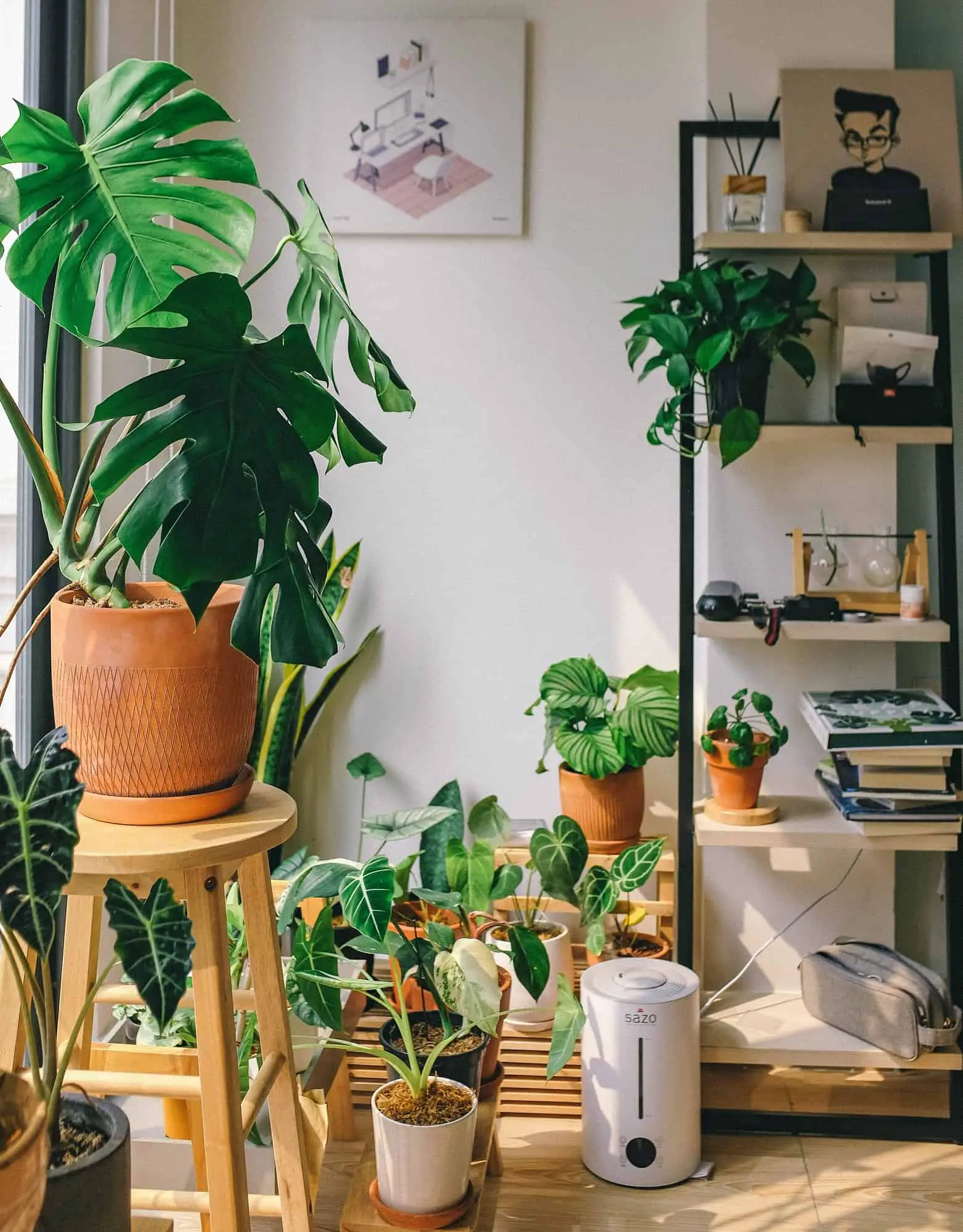
However, plant humidifiers can be expensive. An easy and inexpensive alternative is to use a pebble tray. A pebble tray is a tray full of water and pebbles. Placing a pebble tray near your plant or under its pot. Pebbles trays can also function as a decorative feature.

Potting and Repotting Swiss Cheese Plant
Repot your Swiss Cheese Plant every year or two so it can continue to grow. Ideally, you should repot during the spring (before new leaves start to grow). When repotting, put your plant in a pot that is about 1-2 inches larger than the previous pot. Swiss Cheese Plants do not mind a snug fit, so do not increase the pot size too much. Finally, make sure that you put your Swiss Cheese Plant in a pot that contains drainage holes.
If you have your heart set on putting your plant in a pot without drainage holes, no worries! Simply put your Swiss Cheese Plant in a nursery pot and place the nursery pot within the decorative pot.
Water the plant thoroughly after repotting. Do not fertilize your plant for a couple of weeks after repotting. This will give your plant time to acclimate to its new home and will minimize the chance of transplant shock.
Using A Moss Pole To Support Swiss Cheese Plant
In order for your Swiss Cheese Plant to have the upright look that they have in the wild, you will need to give them some support once they mature. Otherwise, the stems will start to bend under the heavy weight of the plant’s leaves. If your plant is large enough, this can even cause the stems to snap.
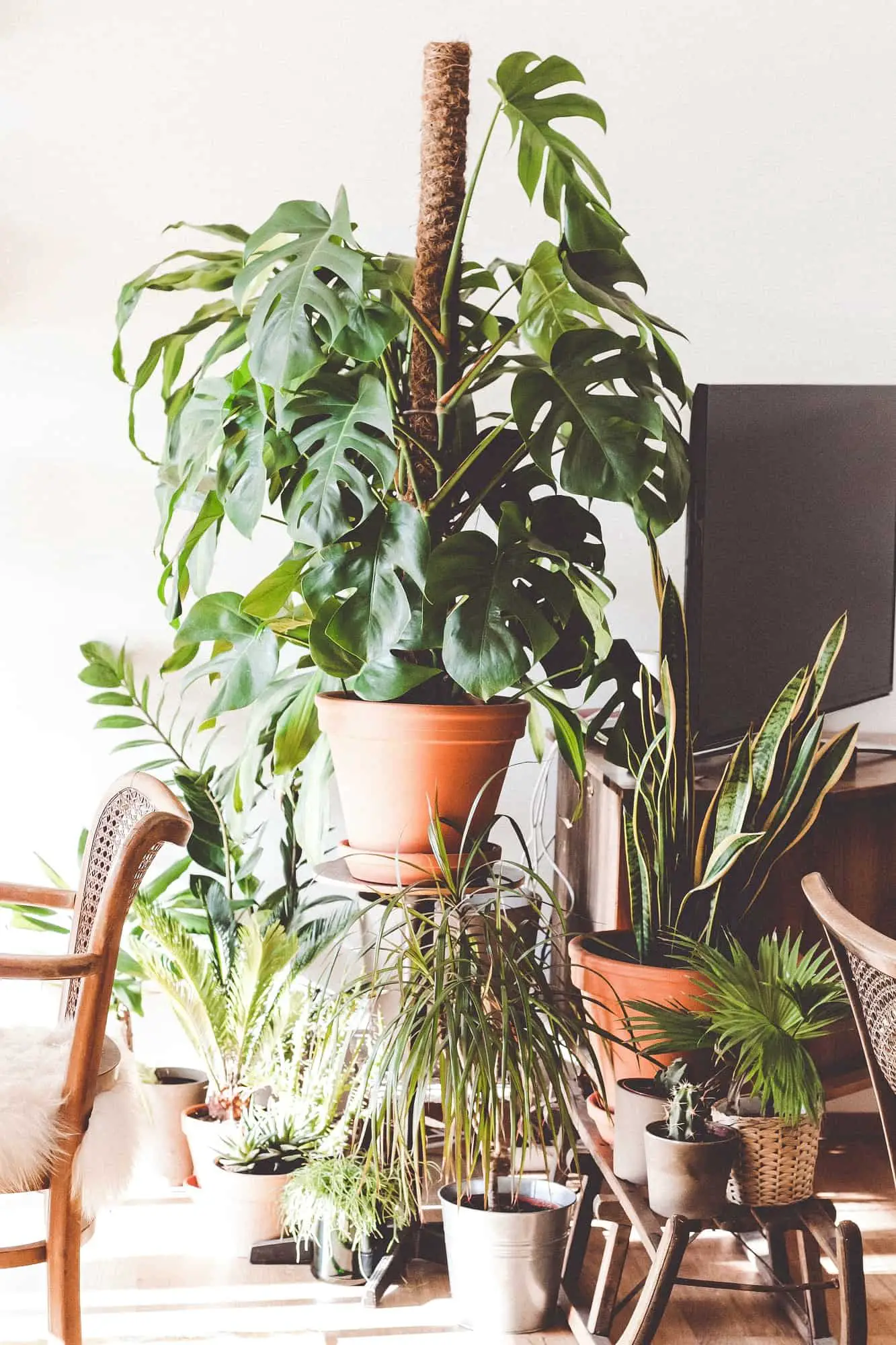
In the wild, these plants climb up tall trees by using their aerial roots to support them as they climb. A moss pole is the most common way to emulate these conditions in your own home.
You can purchase moss poles at gardening centers or online. Alternatively, you can make your own moss pole using a stake, fine wire mesh, and sphagnum moss. Simply, wrap the fine mesh around the stake. You can secure it using staples or clips. Then soak the sphagnum moss in water and put the sphagnum moss in the gap between the wire mesh and the stake.
The video below demonstrates how to make a moss pole using a slightly different method. Side Note: Although the Bloom and Grow Radio YouTube Channel is great, I highly recommend checking out the Bloom and Grow Radio Podcast.
After purchasing or creating your moss pole, you will need to “train” your Swiss Cheese Plant to grow upright. You can do this by simply strapping some of the stems to the pole using a little bit of wire or string. Make sure that you do not tie the wire or string so tightly that it damages the plant tissue.
Finally, make sure that you keep the sphagnum moss moist by spraying it every week or two. This will encourage the plant’s aerial roots to take hold of the pole.
Potential Pest Problems For Swiss Cheese Plant
Swiss Cheese Plant is not particularly susceptible to pests problems, but you should be aware of a few insects that could cause issues.
Note: If your Swiss Cheese Plant is ever infected with insects, it is best to move it away from your other plants. This minimizes the chance of spreading the problem to other plants.
Red Spider Mites
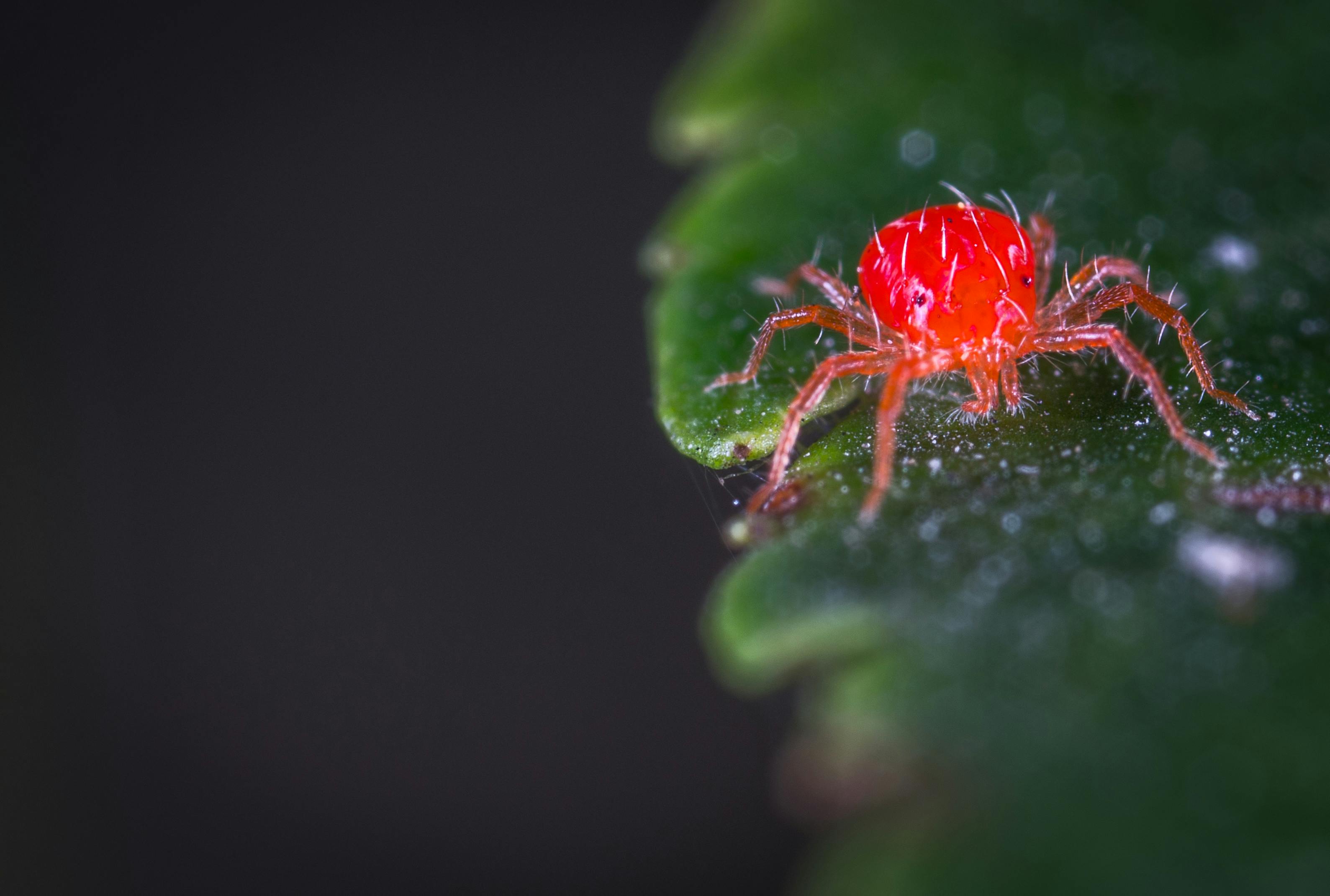
Red spider mites are a common pest that may attack Swiss Cheese Plant. Red spider mites are tiny, red bugs that are common garden pests, and they tend to attack the bottom parts of leaves. In general, red spider mites are attracted to warm, dry environments.
Indications of a spider mite include a white web on the bottom of the leaves or the leaves of your plant turning slightly silver or brown. The leaves change colors because spider mites will suck the nutrients out of leaves which causes the leaves to dry out. You may also see red, yellow, or tan spots on the bottom of the leaves.
Fortunately, you do not have to use harsh chemicals or follow a complicated procedure to get rid of spider mites.
Soap sprays are a common way to combat spider mite infestations. To make the soap spray, simply mix the following ingredients in a clean bucket:
- 2 Tbsp of gentle soap
- 1 Tbsp of cooking oil
- 1 gallon of water
Spray this mixture on your plant. Repeat this process every 4-7 days until the spider mites are gone.
The best way to prevent spider mites is to make sure that your plant is happy and is receiving the proper care. In general, stressed plants are more susceptible to pest problems than healthy plants.
Mealybugs

If you are a succulent owner, you have probably experienced mealybug problems. These pests are a fairly common garden pest that attacks a variety of plants. Mealybugs are a group of about 275 species that are soft-bodied, wingless insects that look like white splotches of cotton on the leaves of plants. Mealybugs damage plants by sucking the sap from the plant tissues. This causes the leaves to yellow and/or curl.
Another indication of a mealybug infestation is the presence of a sticky “honeydew.” This honeydew can cause black, sooty mold. In addition, honeydew often attracts ants.
The avoid a mealybug infestation, do not overwater or overfertilize your Swiss Cheese Plant. Mealybugs are attracted to high nitrogen levels and soft growth.
If you do find that your Swiss Cheese Plant is infested with mealybugs, there are a number of ways you can get rid of them. Some of these control measures include:
- Physical Removal – One of the best ways to get rid of mealybugs is to physically remove them from the plant. Remove the bugs with a paper towel or piece of cloth. Make sure you squish the bugs so they will not crawl back to the plant. Remove all egg sacs, which look like clumps of cotton, from the leaves as well.
- Neem Oil – Mix 2 Tbsp of neem oil in 1 gallon of water. Spray the plant thoroughly. Do not forget to spray the bottom of the leaves.
- Rubbing Alcohol – Dab the mealybugs with a cotton ball or q-tip soaked in rubbing alcohol. This will dry the insects out.
Aphids

Aphids are another insect that attack plants by sucking the sap from their leaves and stems. They are tiny, soft-bodied insects that are barely visible to the naked eye. There are several species of aphids. Some species are black while others are white, yellow, brown, or light green. Over fertilizing can attract aphids because excessive nitrogen encourages tender, leafy growth with a lot of sap.
Signs of an aphid infestation include yellow or curling leaves. Like mealybugs, they also produce a sticky substance called honeydew. Some aphid species can even cause galls, which are abnormal growths, to form on leaves.
According to the Old Farmer’s Almanac, you can get rid of aphids by spraying or wiping the leaves with a mixture of water and a few drops of dish soap. Apply the soapy water every 2 or 3 days for a couple of weeks.
Other aphid control methods include using neem oil, Diatomaceous earth (DE), insecticidal soaps, and dusting the plant with flour to constipate the aphids.
Propagating Swiss Cheese Plant
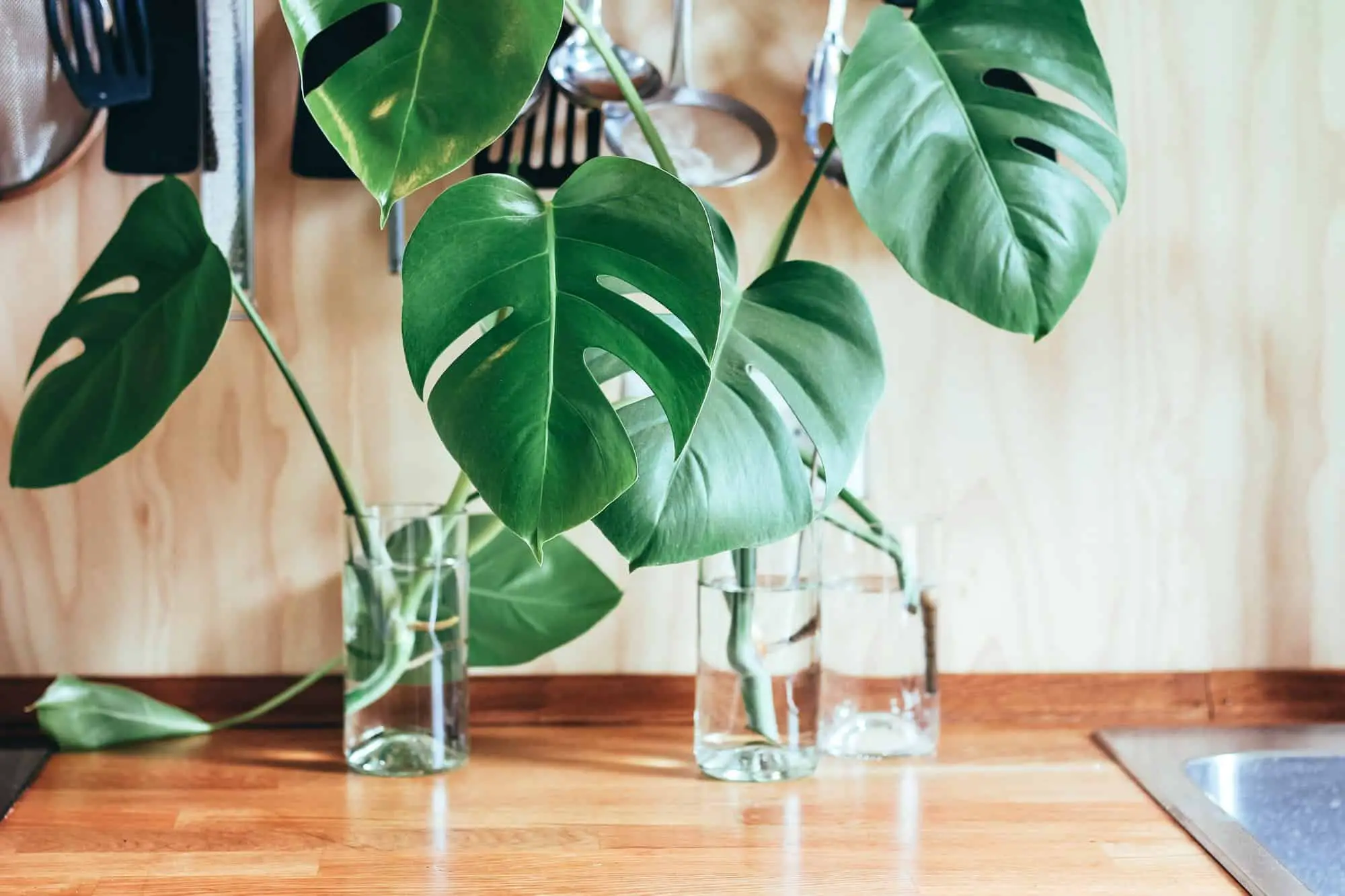
Monstera deliciosa can be propagated by seed, stem cuttings, suckers, or tissue culture. However, the most common way to propagate Swiss Cheese Plant is to put cuttings in water. The process is fairly simple, and the steps are outlined below.
- Use a sharp knife or clippers to take a cutting of your Swiss Cheese Plant. Cut 1/2 to 1 inch below an aerial root. This is important because more roots will grow from the aerial roots when you put them in water.
- Put your cutting in a clear container of water. Make sure that the aerial root is completely submerged in the water.
- Place your cutting in an area that is exposed to bright, indirect sunlight for at least 4-6 hours each day.
- Replace the water every couple of days.
- Roots will begin to grow within 1-2 weeks. After the roots have grown to a length between 2 and 4 inches, plant the cutting in a container of fresh soil.
The video below also demonstrates how to propagate a Monstera deliciosa.
Is Swiss Cheese Plant Toxic?
According to the American Society for the Prevention of Cruelty to Animals (ASPCA), the Swiss Cheese Plant is toxic to cats and dogs. For this reason, it is important to make sure this plant is not accessible to pets or small children.
The Swiss Cheese Plant is toxic to cats and dogs. For this reason, it is important to make sure this plant is not accessible to pets or small children.
Swiss Cheese Plant is toxic because these plants contain insoluble calcium oxalates. Insoluble calcium oxalates are needle-like crystals that are large enough to be visible in damaged plant tissue.
The insoluble calcium oxalates cause irritation of the mouth, lips, and tongue. It can also cause excessive drooling and difficulty swallowing. If swallowed, insoluble calcium oxalates can cause gastrointestinal issues.
Dogs that like to chew houseplants are the most at risk of being poisoned by the Swiss Cheese plant. The plant material causes irritation upon contact, so it is rare for dogs to swallow enough plant material to cause serious damage. However, in rare cases, the dog may experience severe swelling in the throat which leads to asphyxiation.
If you believe that your dog has ingested a portion of your Swiss Cheese Plant, call your veterinarian.

